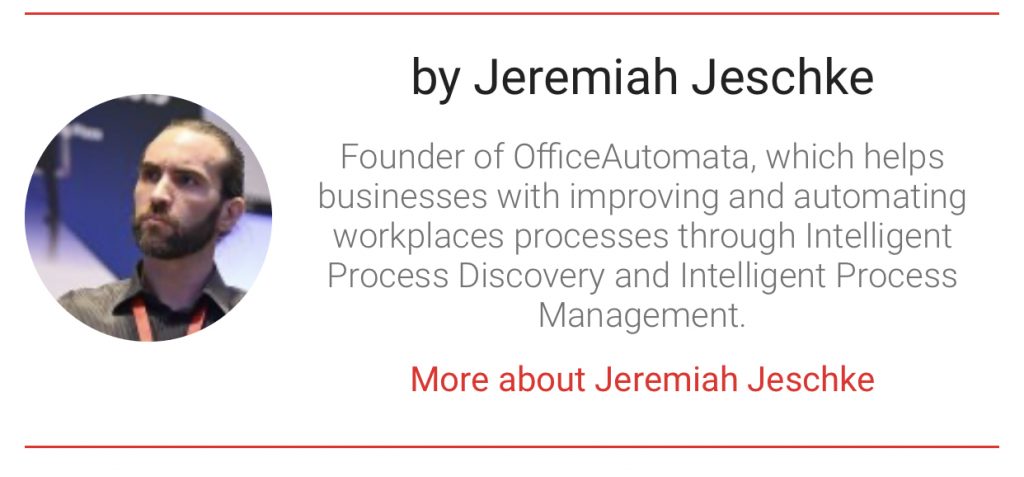It’s the question on every business owner’s lips – what can automation do for us?
The answer: much more than you think.
Some companies consider automation as disruptive, but in fact, it improves the way you do business. 75% of companies believe automation will be vital to delivering goods and services in the future. It makes employees lives easier, happier and it is far less prone to error than any human. Historically, we’ve seen how companies that resist change, such as Nokia did, simply get left behind.
officeAutomata takes you on the Automation Journey, from digitalization to process discovery through automated processes, to help you understand what happens when you decide to automate, and what can be done with the new tools available.
Firstly, in order to understand what automation actually can do for your business, it’s vital to understand what it actually is and how it works.
What is Automation?
Simply put, automation is changing tasks that have been done manually by a human, into processes that can be done by a system, whether that’s a robot, a process or program. Automation has been around in business since the 1950s when General Motors installed Unimate, an industrial robot on their assembly line at a plant in Trenton.
Now automation can be carried out by software that runs in the background and won’t disrupt your daily workflow at all.
Robots and AI systems are built to receive and understand information. They can perform any tasks that they learn.
Changing the Way We Work – Digitalization
Every few decades, the world of work changes. 25 years ago, not everyone had a PC or laptop at work, never mind at home. Fax machines were still used as a method of communication until around a decade ago.
Remember when everything used to be written down? Each company had a policy of keeping documents for a number of years. Reams of paper were stored; it was easy to lose things and difficult to find the information when needed. When we realized we could, we moved to storing everything on our computers. That was much more efficient. However, we had to convert everything into something that could be read on a computer.
First, we began by digitizing everything, and now innovators are taking this further, by using digital technology to advance business. One part of this is automation.
Data, Data, Data
Data is the cornerstone of any organization. No matter what kind of business or industry you’re in, you need data. Companies have been collecting data since business began – even if you think of a local shop in a small village, they probably wrote down orders for different customers and kept them, repeating them on a weekly basis. Nowadays, some companies have more data than they know what to do with. The Global Datasphere is estimated to be 175 ZB by 2025 (it’s currently around 33 ZB!).
It’s also important to make sure that companies retain their process data and process knowledge instead of it walking out the door when employees eventually leave. One of the problems is that most process data is unstructured or not captured. There’s also a chain of human actions with this, which can lead to error; people losing a bit of paper, or not being sure of where they stored it. Companies have to manage how to get everything digitised and then learn what they can do with it. AI can help you understand all this. Automation can use what AI has learnt.
Most process data is unstructured and requires a chain of human actions, therefore it’s important for companies to track and retain their process data and process knowledge. Not doing so means that it likely will walk out the door when employees eventually leave.
Taking time to capture and analyze this process data can take a lot of time for humans, but with AI Process Discovery, the possibilities open up. Trends that weren’t visible before can change how the company does business, and help organizations make money from new revenue streams that may not have been recognized previously. Your data is being used for business intelligence, not lost, or simply being stored on a hard drive, or in the Cloud.
Process Discovery
What can you do with all this data? Any company that carries out computer-based work can benefit from Process Discovery. Also known as Process Mining, this process investigates all the computer-based processes of your business (or at least the ones you want it to – this can be tailored).
AI identifies what your team members are doing regularly and distinguishes the processes, thus providing recommendations on what can be automated. This means that inefficiencies can be isolated, which will make clients happier and add more $$$ to your bottom line.
Many companies are investing hundreds of thousands of dollars in process discovery, with one multinational engineering firm creating robots to “watch” their staff and learn what processes they are doing, and another Fortune 500 company employing actual people to do the same. What they haven’t realized is that software, such as officeAutomata, can actually do this for them – saving them quite a lot of money.
For small-to-medium enterprises, who can’t afford to create robots or hire extra staff, a simple investment in automation software, such as officeAutomata, will mean money saved in the long term. It could mean not having to outsource work to other providers or not setting up a full accounts department.
The Automation Journey
The Automation journey begins when AI software, such as officeAutomata, begins capturing data and learning from your employees as they work. This takes away the need for anyone to be recording or monitoring processes as daily work continues.
Once the processes have been documented by the AI, then specific automations can be built by the AI and/or tailored for your processes by a developer. An initial testing period will take place, so that the automations can be run and tested, ensuring that there are no glitches, and any tweaks that need to be made can be done while it is in a testing period. Once everything is in order, the automations are deployed on remote servers and companies can see the difference, the boost in productivity and the positive change it makes to overhead costs.
AI learns about each organization individually. There’s no one-size-fits-all approach. As the AI keeps learning, it will identify which automations are out-dated or need to be updated. It monitors itself so if there are any errors they can be pinpointed and corrected. Quality Control has never been so easy.
Why Is AI-based Automation So Great?
For a number of reasons. You can keep feeding data to AI – it just learns more. It’s also pretty scalable to any level, once the initial instalment is over and it understands what your organization needs.
Automation works behind the scenes – it never needs to take breaks, can work through the night and doesn’t need holidays. For employees that worry they will no longer be needed – this isn’t the case. It simply means they won’t have to carry out repetitive tasks and can apply their skills more creatively or strategically on tasks that AI can’t be used. They can be moved to higher-value tasks and spend less time on the minutiae that they didn’t like doing anyway.
Ask anyone in the world what he or she wants and a common answer will be “more time”. Automation gives you more time and money. So, it makes sense to start your automation journey sooner, rather than later.
Resources:
- https://valuer.ai/blog/50-examples-of-corporations-that-failed-to-innovate-and-missed-their-chance/
- https://isg-one.com/articles/automation-and-ai-use-to-triple-by-2019
- https://www.robotics.org/joseph-engelberger/unimate.cfm
- https://www.businessnewsdaily.com/10625-businesses-collecting-data.html
- https://www.seagate.com/files/www-content/our-story/trends/files/idc-seagate-dataage-whitepaper.pdf
Article by channel:
Everything you need to know about Digital Transformation
The best articles, news and events direct to your inbox
Read more articles tagged: Automation, Featured







